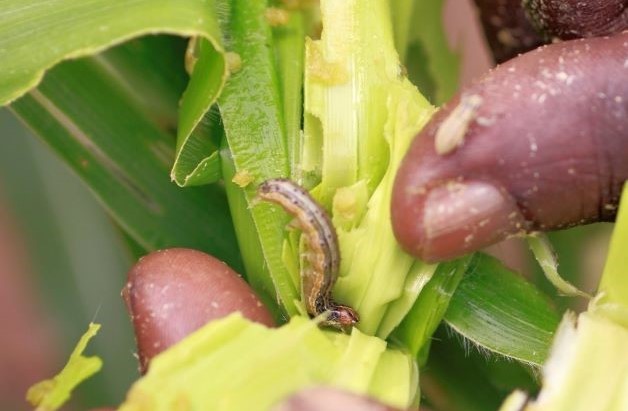The use of information and communication technologies (ICTs), including e-resources, to deliver information has expanded rapidly in recent years and, as an academic publisher in the life sciences, online knowledge sharing has become an increasingly important goal for CABI. Our aim is to help people discover validated, evidence-based information to help them overcome the world’s biggest challenges such as climate change, economic development, food security and gender equality.

When it comes to crop health and food security, information sharing about invasive species is critical. Recent CABI research established that invasive species cost Africa’s agricultural sector an estimated USD $65.58 billion a year.
The Invasive Species Compendium (ISC) is an open access, online resource, published by CABI with the support of donors and partners, that shares information about invasive species. This year, CABI published a working paper, Assessment of the Use and Benefits of the Invasive Species Compendium to analyse usage statistics, data from three user surveys and information from key informant interviews. In this blog, we take a look at six of main benefits and uses of the ISC outlined in the paper.
Invasive Species Compendium Research
In a HotJar survey, 23.4% of ISC users responded that they used the compendium for research. Respondents included professional researchers, academics and students. The users, surveyed from across the globe, commented that the information was valuable and that they were surprised to find all of the information in one place.
Students at BSc, MSc and PhD levels used the ISC for academic purposes in class assignments, course work, term papers, presentations, essays, research papers and theses. Respondents noted that the information was up to date and that the ISC filled information gaps in the research they were undertaking. They recommended the ISC to other students, due to the richness of the available information.

Species identification
Unsurprisingly, 13.6% of ISC users stated they used the ISC for species identification, using it for identification of species collected from the field, plants, insect specimens, as well as to identify which plant species may become invasive in specific locations. They noted that disease identification was possible due to the combination of images and the associated research information contained in the ISC and that they had not found the necessary information elsewhere.
Teaching and training
In the HotJar survey, 11% used of respondents used the ISC information for teaching and training, especially at university level. Information was incorporated into teaching materials, training modules and lectures for both undergraduate and postgraduate students, with one respondent stating they had used ISC information in a project for secondary school students.
Other respondents also used the information to develop training material for farmers, as well as extension materials, stating that the ISC provided good reference material for farmer training and teaching Integrated Pest Management (IPM). Extension officers that operate under CABI’s Plantwise programme commented that they used ISC information for advising farmers on invasive species management.
Invasive Species Compendium Risk assessment and analysis
Pest Risk Assessment (PRA) is a specialised field but, despite this, 9.3% of respondents in the HotJar survey stated that they used the ISC for this purpose, obtaining information about the presence of certain pests in specific geographic locations for use in a PRA. The ISC was used, for example, in the development of pest information packages to support market access for fruit and vegetable exports, and for risk assessments arising from requests to import live plants and seeds.
Information was used to complete pest research and surveys, pest risk models, pest alerts, PRA reports and surveillance plans. Users included people working in plant health quarantine, biosecurity and National Plant Protection Organisations.
Preparation of information materials, databases and management plans
ISC information was used in the development of information materials such as distribution maps, data on biology, dispersal and biological control, and in the development of management plans and pest survey programmes. The pest stage descriptions helped in identifying the pest and discovering which management approaches best fit a management programme for that species.
Other information materials include presentations on mango mealybug, information cards for gardeners and horticulturists to raise awareness about invasive species and a bulletin of the major weeds in India, including their description, distribution, ecology and uses. Information has even been used in agrochemical trial reports and to develop a monograph of medicinal plants, where the origin of the plants was important to know.

General learning and usage
More generally, the ISC has been used to help people learn about invasive insect and plant species including their biology, distribution, known control methods and natural enemies, as well as gaining general knowledge of the invasive species, damage and control and developing proposals for invasive species management.
Other users visited the ISC to learn about the native distribution of species and whether a species is naturalised or invasive in a certain area. Users commented that the photos and images are extremely helpful for disease identification, and that the references act as a guide of where to seek further information when necessary.
Going forward, it is critical that the ISC can remain as an open access resource, with sufficient funding to ensure it is continuously updated. This will enable researchers in the Global South in particular to continue to access key data and literature, while concentrating resources on fieldwork, pest risk analysis, management and control.
Further reading
See the full working paper here: Assessment of the Use and Benefits of the Invasive Species Compendium
See the Invasive Species Compendium: https://www.cabi.org/ISC
For more information on fall armyworm, see the Fall Armyworm Research Collaboration Portal
For more information about CAB’s work in invasive species, go to www.cabi.org/what-we-do/invasive-species
Related News & Blogs
Biological control in action: Zambia’s field days on fighting fall armyworm
Experts from CABI recently held two field days and an expo in Zambia, showcasing innovative approaches to pest management to 584 farmers, agro-dealers and other stakeholders to help raise awareness of approaches to tackle the invasive fall armyworm (Sp…
11 June 2025




